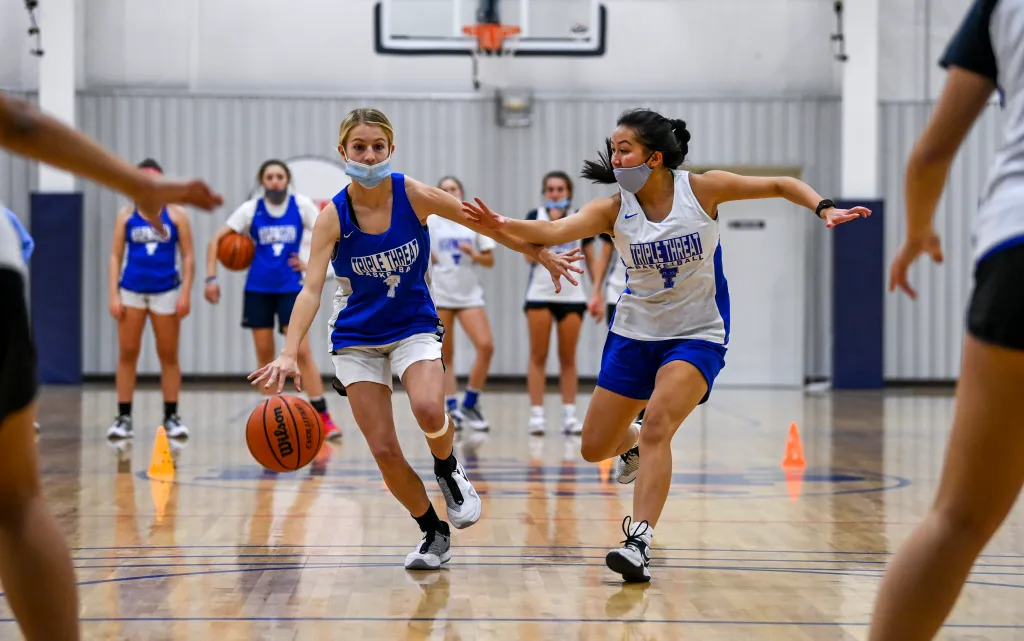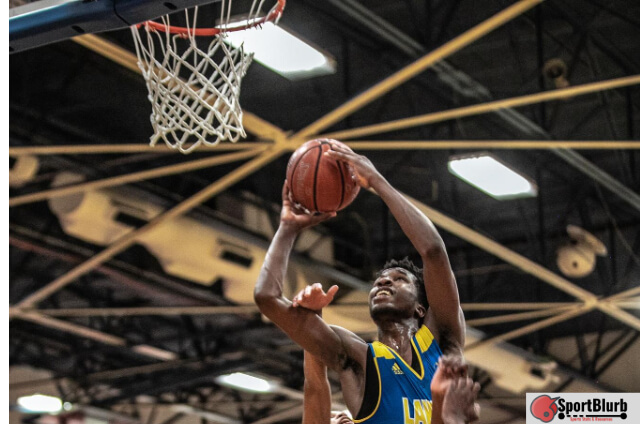Last Updated on October 24, 2023 by Alex PT
Triple threat in basketball is a fundamental stance that allows players to quickly pass, dribble, or shoot. It involves holding the ball with both hands, knees slightly bent, and ready to make an offensive move.
Understanding The Triple Threat

When an offensive player squares up a defender, a triple threat position occurs in the game of basketball. For an offensive player to be in a triple threat stance, he or she must be in an athletic position, meaning his or her body must be ready to move, with his or her knees bent, while the ball must be held either on the left or right hip. In order to maximize your options, you must place one foot in front of the other.
Additionally, the offensive player should have a dribble, which means they’ve simply found the ball from a pass or maybe rebound, & they have to get the court before them. If those needs are achieved, the professional is in a triple threat position. The triple threat is exceptionally common. We commonly see every wing or guard automatically go into a triple-threat position as soon as the ball is passed to them. When they are outside the key, a triple-threat position gives them more options to square up a defender.
How to Master Triple-Threat Position in Basketball
Mastering the triple-threat position in basketball requires practice, focus, and attention to detail. Here’s a step-by-step guide to becoming proficient in this essential skill:
- Fundamental Stance:
- Stand with your feet shoulder-width apart, knees slightly bent for balance and mobility.
- Hold the basketball with both hands, fingers spread and your shooting hand beneath the ball, while the other hand supports from the side.
- Low Athletic Stance:
- Get low by bending at the waist and knees, maintaining balance and agility.
- Keep your back straight and head up, with your eyes on the court to read the defense.
- Ball Positioning:
- Hold the ball close to your body, just above waist level.
- Keep the ball protected from defenders, ensuring it’s not an easy target for steals.
- Flexibility and Balance:
- Work on your flexibility to stay low in the stance while maintaining balance and mobility.
- Practice moving in all directions while staying in the triple-threat stance.
- Quick Decisions:
- Master the art of reading the defense. Assess the defender’s positioning and reactions.
- Decide quickly whether to shoot, pass, or dribble based on the defender’s movements and the offensive opportunities.
- Shot Fake:
- Incorporate shot fakes into your arsenal. Pretend to shoot by lifting the ball slightly, then drive to the basket when the defender reacts.
- Passing Accuracy:
- Develop precision in your passing. Work on passing to different spots on the court with both hands.
- Practice quick, accurate passes to teammates.
- Dribbling Fundamentals:
- Improve your ball-handling skills. Practice dribbling while in the triple-threat stance.
- Work on driving to the basket, change of direction, and crossovers to capitalize on the dribble option.
- Game Scenarios:
- Simulate game situations during practice. Have a coach or teammate play defense, and practice making quick decisions from the triple-threat stance.
- Repetition and Feedback:
- Consistent, deliberate practice is key. Repetition is necessary to develop muscle memory.
- Seek feedback from coaches or experienced players to fine-tune your triple-threat skills.
- Pressure Situations:
- Practice under pressure. Simulate end-of-game or high-pressure scenarios to enhance decision-making and composure.
- Video Analysis:
- Record your practice sessions and games. Analyze your use of the triple-threat position to identify areas for improvement.
Modes Of Attack
If you’re talking about one of the most advantageous positions in basketball, a triple-threat position is one of them. One of the huge parts of this classic sport is anticipation, and when it comes to running a proper offense, keeping your defender on their toes is worthwhile. Normally, a triple threat stance is utilized by centers and guards but forwards can also use a triple threat position to spot up out of the post. If you want to become a serious player, it is necessary to master a good triple threat. When you understand this stance, it will help you know a good offense.
The table below contains questions and answers on the triple threat and what to do to be in that position.
| What’s The Other Name For “Triple Threat”? | The “Triple Threat” is otherwise known as the “Triple Threat Stance”. |
| What To Do To Be In The Triple Threat Position? | You must be in an athletic position, meaning your body must be ready to move, with your knees bent, while the ball must be held either on your left or right hip. |
What Is A Triple Threat?
In the game of basketball, the word “triple threat” is one of the most common terms you’d likely hear during games, practice, or commentary. The term “triple threat” is otherwise known as “triple-threat stance”, meaning a unique way of body positioning by an offensive player to open a wide range of options while on the playing court. However, in football, players known to be triple threats are backs who are skilled at punting, running, and passing. These kinds of players are difficult to find for coaches.
Why Is It Called A Triple Threat?
This term comes from the fact that a player has three options that he or she can make from a triple-threat position. When an offensive player hasn’t used up his or her dribble yet, a triple-threat position is where he or she should be. The triple threat position gives the player three options which include an option to pass, shoot, or to dribble the ball towards the basket.
What Are The Benefits Of Using The Triple Threat Stance?
The triple threat stance in basketball offers several advantages for players:
- Versatility: It provides an immediate threat to the defense by allowing the player to pass, dribble, or shoot, keeping defenders guessing.
- Initiating Offense: Players can start plays from a position of strength, facilitating better ball movement and decision-making.
- Maintaining Possession: Holding the ball close to the body in triple threat minimizes the risk of turnovers and thefts by defenders.
- Creating Space: The stance allows players to protect the ball and use fakes and quick movements to create space and drive past defenders.
- Reading Defenders: It provides a clear view of the court, enabling players to assess defensive movements and exploit weaknesses.
- Drawing Fouls: Quick offensive moves from a triple threat can force defenders to commit fouls, leading to free-throw opportunities.
- Scoring Options: The stance sets up players to efficiently execute jump shots, drives, or passing options, enhancing offensive versatility.
- One-on-One Advantage: It’s a fundamental skill for one-on-one situations, helping players effectively take on defenders.
- Fundamental Skill: Learning the triple threat stance is essential for building a strong foundation in basketball, particularly for young and developing players.
- Confidence: Mastering the triple threat stance builds players’ confidence and decision-making abilities, key to success in clutch moments.
What Three Things Can You Do In A Triple Threat?
In a triple-threat stance in basketball, players have three primary offensive options:
- Shoot: Players can quickly transition from the triple threat stance into a shooting motion. This involves pulling up for a jump shot, taking advantage of open space, and attempting to score. The stance allows the player to maintain balance and be prepared for a shot.
- Pass: From the triple threat, players can make a swift pass to a teammate. The close positioning of the ball to the body and the readiness to pass enable precise and timely distribution of the ball, which is essential for facilitating team offense and creating scoring opportunities.
- Dribble: Players can immediately initiate a dribble, allowing them to drive toward the basket, penetrate the defense, or reposition themselves on the court. The triple threat stance provides a strong starting position for dribbling, with the ball held securely to minimize the risk of turnovers.
Final Words – Wrapping It Up!
As a basketball fanatic, there are several essential terms to find out and memorize. The term “triple threat” is among the most typical terms you would probably hear during games, train, and commentary. We’ve come to the end of this informative article. We hope you were able to find resources in your quest to know the Triple Threat Basketball. Please do not hesitate to contact us for questions or comments. Thanks!

Hi! I’m Alex PT. I hold a Bachelor’s degree in Sports Management from Indiana University and have over seven years of valuable experience working in a Sports Event Management Company. I founded SportBlurb with the passion for bringing you the latest, most insightful, and engaging content in the world of sports. So, whether you’re a die-hard fan or want to stay informed, I’ve got you covered!

